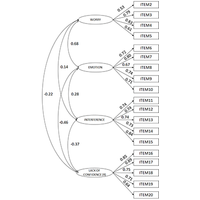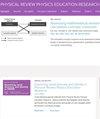Validation of two test anxiety scales for physics undergraduate courses through confirmatory factor analysis and Rasch analysis
IF 2.6
2区 教育学
Q1 EDUCATION & EDUCATIONAL RESEARCH
Physical Review Physics Education Research
Pub Date : 2024-04-11
DOI:10.1103/physrevphyseducres.20.010126
引用次数: 0
Abstract
The assessment of test anxiety has received increasing attention in educational research due to the potential negative effects of anxiety on student performance. Traditionally, test anxiety scales have been developed for mathematics, but few studies have focused on physics. In this study, we validated two test anxiety scales for undergraduate physics courses: the Test Anxiety Inventory for Physics (TAIP) and the Abbreviated Test Anxiety Inventory for Physics scale (ATAIP), which were adapted from existing instruments. A convenience sample of 361 engineering students enrolled in a first-semester introductory physics course participated in the study. Confirmatory factor analysis and Rasch analysis were used to establish the construct validity of both scales. Convergent validity for the TAIP scale was established by examining its correlation with a scale adapted from the math anxiety scale. Criterion-related validity for both TAIP and ATAIP was established by analyzing the relationship between students’ Rasch scores on the two scales and their performance on two conceptual tests. Finally, measurement invariance of TAIP and ATAIP scales was established using both multigroup and differential item functioning analyses to reliably investigate gender differences in the corresponding Rasch measures. The study confirms a robust four-factor structure of the TAIP. The four subscales, Worry, Emotionality, Interference, and Lack of Confidence, demonstrate good reliability (McDonald’s , respectively). Rash analysis also confirms that, for each subscale, the rating scale functioning was consistent with the item difficulty and person measures. The TAIP also demonstrates adequate convergent and criterion-related validity, as well as measurement invariance with respect to gender. The ATAIP also demonstrates good reliability (McDonald’s ), a well-functioning rating scale, and sufficient criterion-related validity. Additionally, it exhibits measurement invariance with respect to gender. Overall, the study supports that both the TAIP and ATAIP scales are reliable instruments for measuring students’ test anxiety in an undergraduate physics course. Implications for physics instruction at the university introductory level are briefly discussed.

通过确证因子分析和拉施分析验证物理学本科课程的两个考试焦虑量表
由于焦虑对学生成绩的潜在负面影响,考试焦虑的评估在教育研究中受到越来越多的关注。传统上,考试焦虑量表是针对数学而开发的,但很少有研究关注物理。在本研究中,我们验证了两个适用于本科物理课程的考试焦虑量表:物理考试焦虑量表(TAIP)和物理考试焦虑量表缩写表(ATAIP)。这项研究的样本来自 361 名修读物理入门课程第一学期的工科学生。研究采用了确认性因子分析和 Rasch 分析来确定两个量表的建构效度。通过检验 TAIP 量表与数学焦虑量表的相关性,确定了 TAIP 量表的收敛效度。通过分析学生在两个量表上的 Rasch 分数与他们在两个概念测试中的表现之间的关系,确定了 TAIP 和 ATAIP 的标准相关效度。最后,通过多组分析和差异项目功能分析,确定了 TAIP 和 ATAIP 量表的测量不变性,从而可靠地研究了相应 Rasch 测量中的性别差异。研究证实 TAIP 具有稳健的四因子结构。担心、情绪化、干扰和缺乏自信这四个分量表显示出良好的信度(麦克唐纳ω分别为 0.78、0.86、0.87、87)。Rash 分析也证实,对于每个分量表,评分量表的功能与项目难度和人的测量结果是一致的。TAIP 还显示了充分的收敛效度和标准效度,以及与性别相关的测量不变性。ATAIP 也表现出良好的信度(麦当劳 ω=0.84)、功能完善的评分量表和充分的标准相关效度。此外,它还表现出与性别相关的测量不变性。总之,本研究证明 TAIP 和 ATAIP 量表是测量本科生物理课程中学生考试焦虑的可靠工具。本研究还简要讨论了对大学入门级物理教学的启示。
本文章由计算机程序翻译,如有差异,请以英文原文为准。
求助全文
约1分钟内获得全文
求助全文
来源期刊

Physical Review Physics Education Research
Social Sciences-Education
CiteScore
5.70
自引率
41.90%
发文量
84
审稿时长
32 weeks
期刊介绍:
PRPER covers all educational levels, from elementary through graduate education. All topics in experimental and theoretical physics education research are accepted, including, but not limited to:
Educational policy
Instructional strategies, and materials development
Research methodology
Epistemology, attitudes, and beliefs
Learning environment
Scientific reasoning and problem solving
Diversity and inclusion
Learning theory
Student participation
Faculty and teacher professional development
 求助内容:
求助内容: 应助结果提醒方式:
应助结果提醒方式:


